Think about how you shop online these days. Are you mostly browsing on a big desktop computer, perhaps occasionally? Or are you, like millions of others, scrolling through products, comparing prices, and making purchases directly from your smartphone , while relaxing on the couch, commuting on the train, or waiting in line for coffee?
The answer is clear: mobile-first design
This fundamental shift means that designing your online store with desktop users as the main focus, and then shrinking it down for phones as an afterthought, simply doesn't cut it. Welcome to the era of Mobile-First Design. It's not just a buzzword or a trend; it's the smartest, most effective mobile-first strategy for e-commerce today.
At Mobisoft Infotech, we specialize in creating winning e-commerce website design setups tailored for modern shoppers. Putting the mobile shopping experience front and center is critical. Let's explore why designing for the smallest screen first is crucial for your online store's mobile optimization, survival, and spectacular growth.
What Does "Mobile-First" Actually Mean? (It's Simpler Than You Might Think!)
For years, the standard approach was "desktop-first." Businesses designed elaborate websites for large computer screens, packed with features. Then, they'd try to adapt that complex design to smaller mobile screens using techniques like "mobile responsive design." While helpful, this often resulted in mobile sites that felt cramped, slow, or awkward to use.
Mobile-first design flips that entire process on its head.
It means you start the design process by thinking about the smartphone user first. You focus on:
- What are the absolute essential features they need?
- How can navigation be simple and intuitive using just a thumb?
- How can the experience be lightning-fast and crystal clear on a small screen?
Start by designing the core experience for mobile-first UI/UX. Keep it lean, fast, and easy to use.
Once that’s solid, adapt the design for larger screens like tablets and desktops. Use the extra space to add helpful features or rearrange elements for a better experience.
It’s a bit like getting ready for a trip. You start with the essentials to make sure everything fits and works well. If there’s extra room, you add a few extras to make things more comfortable.
Why is Mobile-First So Insanely Important for Online Stores Right Now?
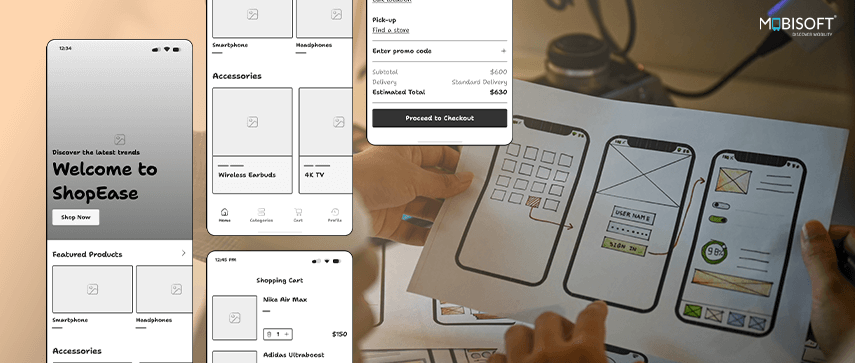
Ignoring your mobile audience isn't just leaving money on the table; it's actively pushing customers away and hurting your visibility:
- That's Where Your Customers Are: Study shows the majority of e-commerce traffic now originates from mobile devices. If browsing and buying on your mobile-friendly e-commerce site is a frustrating experience, you're alienating the largest chunk of your potential buyers from the get-go.
- Google Demands It (Mobile-First Indexing): This is huge. Google mobile ranking is now determined primarily by the mobile version of your site. That means even your desktop SEO depends on how well your mobile responsive SEO is set up. A poor mobile site means poor overall SEO performance. A great mobile experience is no longer optional for being found on Google.
- Happy Mobile Users = More Sales: Mobile shoppers value speed and convenience. A simple, fast, intuitive mobile e-commerce UX makes it easy for them to find what they want and check out quickly. Clunky navigation, slow load times, or tiny buttons lead directly to abandoned carts. Explore our mobile app design services to craft seamless mobile shopping experiences.
- Mobile Discovery and Impulse Buys Are on the Rise: More and more customers find products through social media, emails, or texts on their phones. These micro-moments often lead to impulse purchases, so your online store mobile optimization must be seamless to capture them.
- Competitors Are Already Doing It: If your competitors offer a fast, easy mobile-first shopping experience and yours feels outdated or clunky, customers won’t stick around. They’ll move on without a second thought.
This shift is accelerating with innovations in fulfillment and delivery speed.Learn how this trend is evolving in our blog on Quick Commerce & Express Delivery: The Future of Online Shopping.
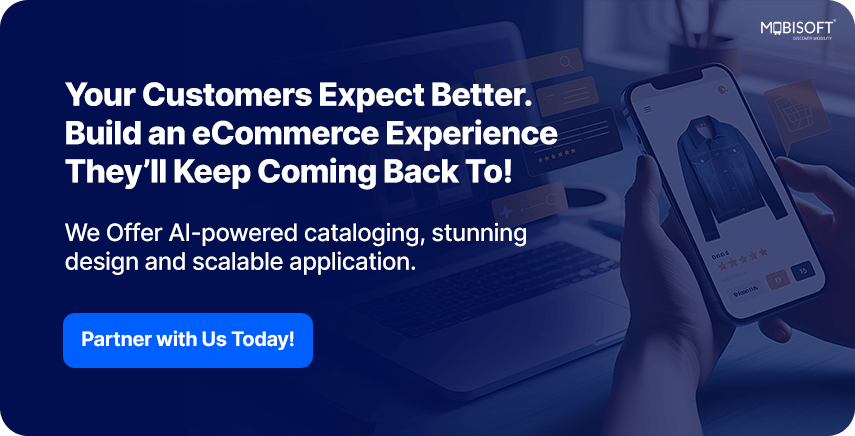
So, What Makes a Great Mobile-First E-commerce Experience?
- Thumb-Friendly Navigation: People browse with one hand. Make sure buttons, links, and menus are easy to tap with a thumb. Keep it simple. Use clear icons and easy-to-find menus. Avoid clutter on the screen. This is the heart of touch-friendly design.
- Clear Call-to-Actions (CTAs): Your main buttons like “Add to Cart” or “Buy Now” should be big and bright. They need to stand out. When someone is ready to buy, the button should be easy to find and tap.
- Blazing Speed: Page speed on mobile is non-negotiable. Mobile users are impatient. Every element needs to be optimized for fast loading, compressing images, streamlined code, fewer pop-ups, and a sharp focus on core functionality.
- Optimized Visuals: High-quality product images and videos are essential, but they must be optimized for mobile display so they load quickly without consuming excessive data.
- Streamlined Checkout: Make buying easy. Keep the steps short. Use fewer form fields. Reduce the number of clicks. Offer guest checkout. Provide mobile-friendly payment options like Apple Pay, Google Pay, or PayPal.
- Effortless Readability: Pick clear fonts. Make them big enough to read on a small screen. No need to zoom all the time. Ensure the text stands out from the background for a clean and readable mobile-first UI.
- Clean, Focused Layout: Don't overwhelm users. Show the most important things first. Use white space well. This creates a calm and clear feel.
Tech for Great Mobile Experiences
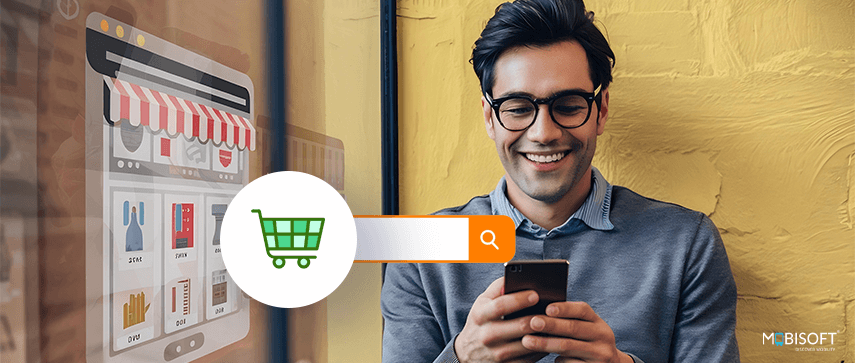
Modern technology helps create amazing mobile-first experiences. It's now easier and more powerful than ever to deliver fast, reliable, and optimized mobile shopping journeys.
- Progressive Web Apps (PWAs) : PWAs make websites feel like apps in the browser. They load fast, work offline, send notifications, and can be added to the home screen without an app store. This significantly boosts mobile engagement and improves overall mobile website performance.
- Headless Commerce: This setup separates what you see (the front) from how things work (the back). It allows you to build mobile-optimized online stores using the best front-end tools while communicating seamlessly with the backend. The result is a faster, more dynamic, and responsive e-commerce design not tied down by desktop constraints. Learn how our mobile commerce solutions can power mobile-first shopping journeys.
- AI Personalization : AI can customize what users see on mobile,like suggesting products, displaying personalized search results, or offering time-sensitive deals. It uses real-time data like location, device, and browsing history to enhance the e-commerce mobile UX and make each interaction more relevant and timely.
For a deeper dive into how AI is transforming mobile-first UX with smart suggestions and predictive recommendations, check out our post on AI in E-commerce: Personalized Shopping & Product Recommendations.
How Global Companies Win with Mobile-First (And Boost Profits)

Successful brands don’t just have a mobile site,they optimize online stores for mobile and design with mobile-first strategy for e-commerce in mind. Look at:
- Fashion & Apparel Giants (e.g., ASOS, Shein, Zara): Their apps and mobile sites are often their primary sales channels. They feature highly visual, easily scrollable interfaces, simple navigation optimized for discovery, quick-add-to-cart options, and super-smooth checkouts, capitalizing on fashion's impulse-driven nature.
- Online Marketplaces (e.g., Amazon, Etsy, eBay): These platforms live and breathe mobile. Their apps are constantly refined for speed, personalized discovery ("inspired by your browsing"), and one-click purchasing, driving massive mobile-first e-commerce transaction volumes and enhancing mobile-friendly e-commerce experiences.
- Food Delivery & Ride-Sharing (e.g., DoorDash, Deliveroo, Uber): These businesses are built for mobile. Their entire service relies on apps that are fast, easy to use, and aware of your location. A smooth, intuitive touch-friendly design is key to how they work and why they succeed.
- Travel & Hospitality (e.g., Booking.com, Airbnb, Expedia): These apps make it easy to search, compare, book, and manage trips,all from your phone. They know people often plan while on the go, make last-minute bookings, or check details during their trip. That’s why a strong mobile shopping experience and responsive e-commerce design matter so much here.
These companies see direct, measurable profitability gains from their mobile-first strategy for e-commerce:
- Higher Mobile Conversion Rates: An easy, fast mobile experience turns browsers into buyers far more effectively, helping improve mobile conversions.
- Increased Organic Traffic: Google rewards great mobile-first indexing and performance with better rankings.
- Lower Bounce Rates: People stay longer when the mobile-first design is smooth and engaging.
- Reduced Cart Abandonment: A simple, fast checkout keeps shoppers moving. Fewer steps mean fewer people drop off before finishing their purchase.
- Stronger Customer Loyalty: When the mobile experience feels good, people come back. They’re more likely to download the app, return to shop, and stay connected over time.
Getting Started: Putting Mobile Front and Center

Ready to embrace a truly mobile-first approach?
- Honestly Audit Your Current Mobile Site: How does it really feel to use on different phones? Use real devices, not just emulators. Use tools like Google's Mobile-Friendly Test and PageSpeed Insights.
- Prioritize Ruthlessly: What absolutely must be on the mobile screen for a user to achieve their goal? Start with the essentials and build outwards.
- Obsess Over Speed: Make fast load times your top technical priority. Every millisecond counts.
- Test Continuously: Get feedback from real users on different devices. Watch how they interact with your mobile site.
- Partner Wisely: Work with developers or an agency (like Mobisoft Infotech!) that deeply understands mobile-first principles, user experience, and modern technologies like PWAs and Headless Commerce.
Conclusion: Your Pocket-Sized Storefront is Your Most Important One
In today’s e-commerce world, your mobile presence isn’t just a nice-to-have. It’s often your most important storefront. When you design with a mobile-first mindset, you meet customers where they are. You give them an experience they enjoy. You also boost your search engine visibility through mobile-first indexing, increase sales, and build a stronger business.
By focusing on speed, simplicity, and ease of use,especially on small screens,you set your store up to thrive in the mobile-first e-commerce world.
Curious about real-world success stories? Learn how we helped a global brand expand digitally in Fashion Retailer’s Online Transformation for Global Reach.
Is your online store truly designed for the palm of your customers' hands?
If you're ready to create an e-commerce mobile UX that shines on every device, starting with mobile, Mobisoft Infotech is here to guide you. We build fast, intuitive, conversion-focused online stores, optimized for the way people shop today. Contact us to explore how a mobile-first strategy for e-commerce can revolutionize your business.
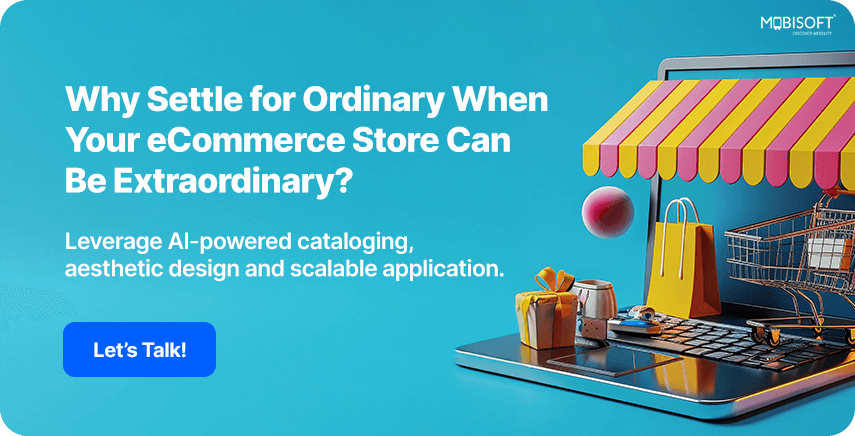

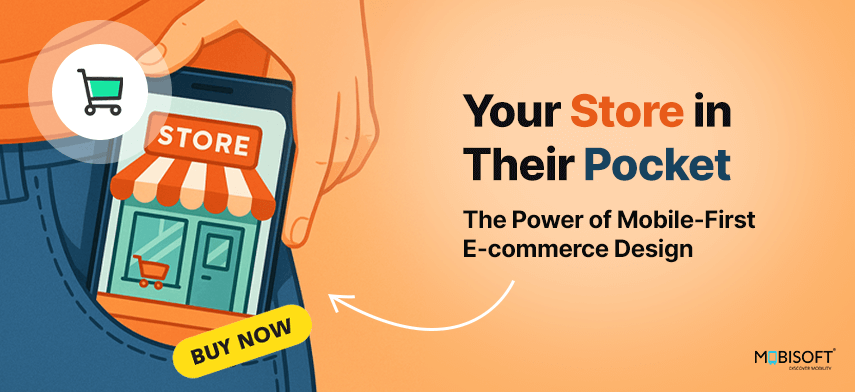


 May 19, 2025
May 19, 2025


